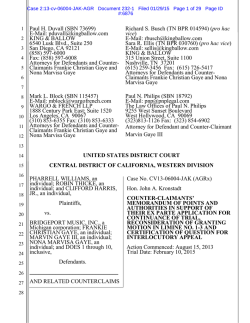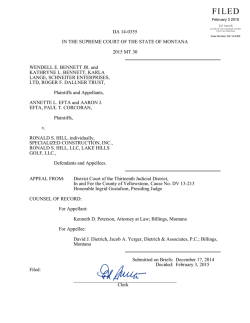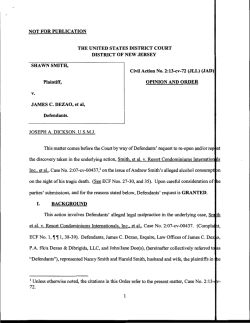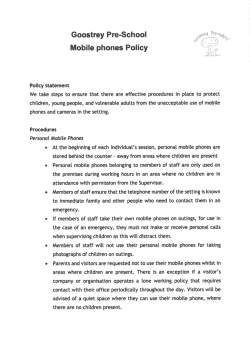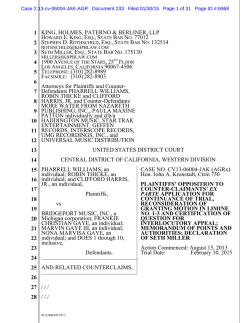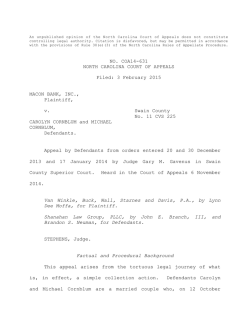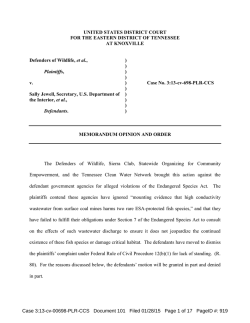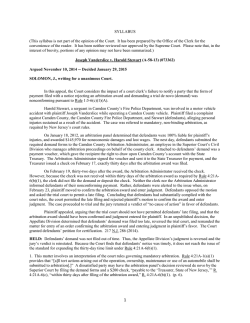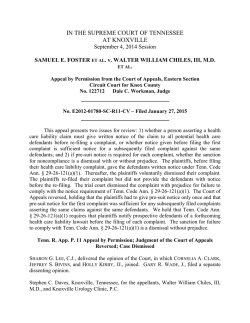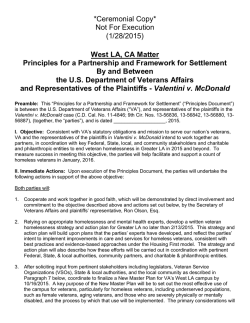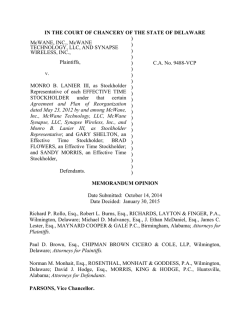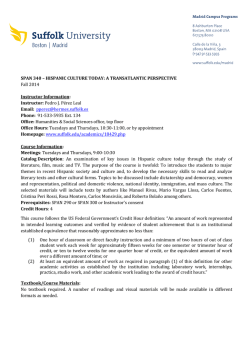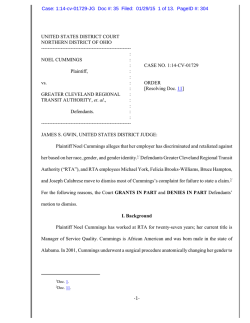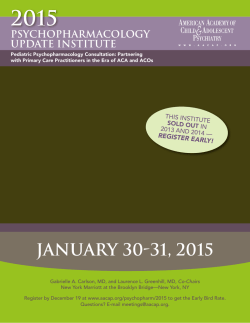
Gov Uscourts Cacd 569559 231 0 (PDF)
Case 2:13-cv-06004-JAK-AGR Document 231 Filed 01/28/15 Page 1 of 6 Page ID #:6867 UNITED STATES DISTRICT COURT CENTRAL DISTRICT OF CALIFORNIA CIVIL MINUTES – GENERAL Case No. LA CV13-06004 JAK (AGRx) Title Pharrell Williams, et al. v. Bridgeport Music, Inc., et al. Present: The Honorable January 28, 2015 JOHN A. KRONSTADT, UNITED STATES DISTRICT JUDGE Andrea Keifer Not Reported Deputy Clerk Court Reporter / Recorder Attorneys Present for Plaintiffs: Attorneys Present for Defendants: Not Present Not Present Proceedings: I. Date (IN CHAMBERS) ORDER RE ADMISSIBILITY OF SOUND RECORDING EVIDENCE AT TRIAL Introduction On October 30, 2014, the Court ruled on the Motion for Summary Judgment of the Plaintiffs and Counterclaim-Defendants in this action. Dkt. 139. Although summary judgment was denied, it was determined that there was merit to the position of the movants that the copyright deposits of the Marvin Gaye songs “Got to Give It Up” and “After the Dance,” rather than the recordings of these songs, defined the scope of the copyrights in the compositions claimed by Defendants. As discussed in detail in that Order, this is because the songs were created and registered under the Copyright Act of 1909 (“1909 Act”), which affords protection to compositions only upon their “publication.” Id. at 8-9 (citing cases). After the 1909 Act was superseded by the Copyright Act of 1976 (“1976 Act”), Congress clarified, and the Ninth Circuit has held, that the release of a phonographic record is not a “publication” for purposes of the 1909 Act, and never was. 17 U.S.C. § 303(b) (1997); ABKCO Music, Inc. v. LaVere, 217 F.3d 684, 691 (9th Cir. 2000). Although publication could be effected by means other than the filing of a copyright deposit, Defendants offered no evidence that the compositions had otherwise been published as defined by the 1909 Act. The Summary Judgment Order was limited to the “extrinsic similarity” between the Gaye compositions and the allegedly infringing works. See Swirsky v. Carey, 376 F.3d 841, 845 (9th Cir. 2004), as amended on denial of reh'g (Aug. 24, 2004). “Intrinsic similarity,” which relates to “substantial similarity in expressions ... depending on the response of the ordinary reasonable person,” is an issue for the finder of fact, and was not discussed in that Order. Shaw v. Lindheim, 919 F.2d 1353, 1356 (9th Cir. 1990) (citation omitted). Plaintiffs filed a motion in limine to exclude evidence of the sound recordings at the trial on the grounds that they contain subject matter that is not protected by the copyrights, the admission of which they claim would be irrelevant and prejudicial. Dkt. 165. At the January 26, 2015 hearing on the Parties’ Motions in Page 1 of 6 Case 2:13-cv-06004-JAK-AGR Document 231 Filed 01/28/15 Page 2 of 6 Page ID #:6868 UNITED STATES DISTRICT COURT CENTRAL DISTRICT OF CALIFORNIA CIVIL MINUTES – GENERAL Case No. LA CV13-06004 JAK (AGRx) Title Pharrell Williams, et al. v. Bridgeport Music, Inc., et al. Date January 28, 2015 Limine, the Court expressed its view that it would grant this Motion, and preclude the use of recordings that included, among other unprotected elements, the voice of Marvin Gaye. Dkt. 226. Defendants raised several objections at the hearing and in their opposition papers. Dkt. 186. They also proposed to prepare a modified version of one or more recordings for possible admission at trial. The Court adhered to its view. Upon reflecting further upon the positions of the Parties regarding these issues, the Court deemed it appropriate to issue this written ruling clarifying and modifying its earlier position. At the January 26, 2015 hearing, the Court expressed its view that Gaye’s voice as embodied in the sound recordings would not be admissible because it is not protected by the composition copyrights at issue. E.g., Dkt. 229 at 9, 17-21, 61. This Order represents a change from this earlier view based on the Court’s further sua sponte consideration of the proof required under the intrinsic test. II. Under the 1909 Act, “Publication,” Which Does Not Include the Release of Sound Recordings, Defines What Is Protected by Copyright, and the Deposit Sheets Are the Only Offered Publications of the Compositions at Issue The Court continues to adhere to the view that the copyright deposit sheets, rather than the sound recordings, define the scope of the subject matter protected by the copyrights asserted by Defendants. Defendants’ arguments to the contrary are unpersuasive. First, they argue, “all experts agree that a full composition is embodied within a sound recording and that lead sheets do not fully encompass the composition.” Dkt. 186 at 3. As discussed in the Summary Judgment Order, what musicologists may believe about what embodies a “composition” does not bear on what is protected under the 1909 Act. Dkt. 139 at 8. Second, Defendants rely on Three Boys Music Corp. v. Bolton, 212 F. 3d 477 (9th Cir. 2000). There, the Ninth Circuit held that a trial court did not err in admitting a sound recording as evidence of what was encompassed by a 1909 Act composition copyright. Defendants argue that Three Boys should be read to mean that compositional elements that are present in a recording, but not in a lead sheet, may be considered in a 1909 Act infringement suit. Dkt. 186 at 6-7; 212 F.3d at 480-81. This argument was previously found unpersuasive. See Dkt. 139 at 10-11. There is no basis to modify this conclusion as a result of the Three Boys appellate and trial court records subsequently submitted by Defendants. Dkts. 133, 225. The Three Boys Court declined to find “clearly erroneous” the jury’s finding of substantial similarity even though the jury considered unprotectible elements, including material present in the sound recordings, but not in the copyright deposit. 212 F.3d at 485-86. The Ninth Circuit noted that “[Plaintiffs’] expert, Dr. Eskelin, testified that the deposit copy included all of the song's essential elements such as the title hook, chorus, and pitches. Dr. Eskelin even played the deposit copy for the jury on the keyboard.” Id. at 486.1 Thus, Three Boys held that the jury’s consideration of this material 1 This was noted in connection with an argument that the court lacked subject matter jurisdiction because the plaintiffs failed to register a complete copy of the song on which the lawsuit was based. Three Boys, 212 F.3d at Page 2 of 6 Case 2:13-cv-06004-JAK-AGR Document 231 Filed 01/28/15 Page 3 of 6 Page ID #:6869 UNITED STATES DISTRICT COURT CENTRAL DISTRICT OF CALIFORNIA CIVIL MINUTES – GENERAL Case No. LA CV13-06004 JAK (AGRx) Title Pharrell Williams, et al. v. Bridgeport Music, Inc., et al. Date January 28, 2015 was not error of a magnitude requiring reversal of the verdict in light of the other sufficient evidence on which that verdict was based. It did not hold that the composition copyrights at issue actually encompassed this material. Third, in a related argument, Defendants contend that the contents of a sound recording embodying a 1909 Act composition may support an infringement claim under the doctrine that “a combination of unprotectible elements can be protected and infringed upon.” Dkt. 186 at 7 (citing Three Boys, 212 F.3d at 485). But, this doctrine is based on the principle that “originality may be found in taking the commonplace and making it into a new combination or arrangement.” United States v. Hamilton, 583 F.2d 448, 451 (9th Cir. 1978). For example, a composition may combine a “chord progression, key, tempo, rhythm, and genre,” that, while individually unprotected, may become a copyrightable work of authorship when grouped together. Swirsky v. Carey, 376 F.3d 841, 848 (9th Cir. 2004), as amended on denial of reh'g (Aug. 24, 2004). To be considered in this fashion, the unprotected elements must still be parts of the copyrighted work. Id. at 849. As discussed, it is the deposit copy -- or other relevant “publication” -- that defines the scope of the copyrighted work under the 1909 Act. The sound recording has no bearing on its scope. Therefore, the compositional elements discussed in Swirsky and similar cases are “unprotectible” for a different reason than elements that appear in a sound recording but not its underlying 1909 Act composition. Elements of the former kind are part of the work, but too “commonplace” to merit protection by themselves; elements of the latter kind are not part of the work at all, however original. As such, the combination doctrine does not apply here. Fourth, Defendants cite several cases in which district courts admitted sound recording evidence in copyright infringement cases that concerned compositions governed by the 1909 Act. Dkt. 186 at 10 n.5. However, in none of these decisions, with the possible exception of the Three Boys case already discussed, does it appear the admission of this evidence was challenged by the opposing party, nor did any of these courts rule on whether material that appeared in a sound recording, but not in the composition, was protected by the copyright in the composition. For these reasons, elements that appear in the Gaye sound recordings, but are absent from the copyright deposit sheets -- the only publications submitted by Defendants as evidence of their copyright ownership -- are not protected by the copyrights asserted by Defendants. 486. Page 3 of 6 Case 2:13-cv-06004-JAK-AGR Document 231 Filed 01/28/15 Page 4 of 6 Page ID #:6870 UNITED STATES DISTRICT COURT CENTRAL DISTRICT OF CALIFORNIA CIVIL MINUTES – GENERAL Case No. LA CV13-06004 JAK (AGRx) Title Pharrell Williams, et al. v. Bridgeport Music, Inc., et al. Date January 28, 2015 III. Whether Portions of the Sound Recordings Substantially Reflecting the Copyrighted Compositions May Be Admissible As discussed in detail in the Summary Judgment Order, the Marvin Gaye sound recordings contain a number of elements that appear in the copyright deposit sheets offered in connection with that Motion.2 With regard to “Blurred Lines,” these include a bass introduction, chords, and the melody sung by Gaye, along with the lyrics sung to this melody. Dkt. 139 at 13-24. Elements that appear in the sound recording, but not the copyright deposit, include backup vocals, percussion parts and the use of party noises as accompanying sound. Id. at 17-18, 21. In addition, the distinctive sound of Marvin Gaye’s voice is beyond the scope of the composition copyrights at issue. See 1-2 Nimmer on Copyright § 2.10 (performer’s “emphasis,” “shading,” “tone of voice,” “inflection,” and “timing of a vocal rendition” may be copyrightable under 1976 Act as a sound recording, which “must be distinguished from . . . the underlying musical composition”). Therefore, although the Gaye sound recordings may embody the copyrighted compositions at issue, they also contain additional material. Consequently, there is a measurable risk that their wholesale admission into evidence would unfairly prejudice Plaintiffs. Fed. R. Evid. 403. In performing their intrinsic analysis of the songs, jurors would be required to filter out such elements as percussion, party sounds and backup vocals that could well influence their responses to the songs as “ordinary reasonable person[s],” and it could be difficult for them to mentally separate what is and is not protectable in this capacity. Shaw v. Lindheim, 919 F.2d 1353, 1356 (9th Cir. 1990) (citation omitted). Further, there would be little probative value in asking them to perform this challenging task. Thus, even if it were determined that Plaintiffs copied any unprotected elements embodied in the recordings, this would not tend to make it more or less probable that they copied protected elements of the compositions at issue. Fed. R. Evid. 401.3 There is merit, however, to Defendants’ contention that it could be difficult for them to present their evidence of intrinsic similarity if the sound recordings are inadmissible in their entirety. Dkt. 186 at 9-10. “The intrinsic test is subjective and asks whether the ordinary, reasonable person would find the total concept and feel of the works to be substantially similar.” Three Boys Music Corp. v. Bolton, 212 F.3d 477, 485 (9th Cir. 2000) (internal quotation marks omitted). “In decisions under the intrinsic test, analytic dissection and expert testimony are not appropriate.” Shaw, 919 F.2d at 1356. As the ordinary person presumably cannot sight-read music and determine its sound, the sheet music alone is inadequate for 2 On the day of the Final Pretrial Conference, Defendants submitted copyright deposit sheets that they contend are authenticated, and that may differ from those offered in connection with the Motion for Summary Judgment. This Order expresses no view on which copyright deposit or other printed material is the relevant “publication” for purposes of determining the scope of Defendants’ copyrights under the 1909 Act. 3 At the January 26, 2015 hearing, Defendants advanced the theory that Plaintiffs’ alleged copying of these unprotected elements could prove that they “had the recording and that they had that in mind and they were copying the compositional elements of the song.” Dkt. 229 at 76. This theory is too attenuated to justify the admission of recordings of these elements where, as here, Plaintiffs’ access to the works is conceded, and the risk of prejudice is present. Page 4 of 6 Case 2:13-cv-06004-JAK-AGR Document 231 Filed 01/28/15 Page 5 of 6 Page ID #:6871 UNITED STATES DISTRICT COURT CENTRAL DISTRICT OF CALIFORNIA CIVIL MINUTES – GENERAL Case No. LA CV13-06004 JAK (AGRx) Title Pharrell Williams, et al. v. Bridgeport Music, Inc., et al. Date January 28, 2015 purposes of this test. As Shaw suggests, the testimony of Defendants’ experts that the works are similar is not appropriate for purposes of the intrinsic test. Plaintiffs have proposed that the musicologists can “play[] on a keyboard at trial the elements of the sheet music deposit copies for the Gaye compositions that are claimed to be similar to Plaintiffs’ two songs.” Dkt. 165 at 9. Although this method may be helpful for focusing the jury’s attention on particular elements, if this were the only evidence presented as to the intrinsic qualities of the Gaye compositions, the jury may not have the opportunity to consider elements of the compositions that are properly within the scope of the subject matter protected by Defendants’ copyrights. The copyright deposits are not comprised of notes alone. They contain lyrics to be sung to melodies, as well as certain other elements. The “total concept and feel” of a piano tune without words may differ from that of a vocal melody. For these reasons, relevant portions of the Gaye sound recordings that substantially reflect the subject matter of the copyright deposit sheets could have probative value with regard to the intrinsic characteristics of the works. To avoid prejudice to Plaintiffs, these recordings would need to be edited to remove all unprotected elements such as percussion and backup vocals. In addition, the length of such edited recordings would be considered in evaluating whether they were tailored to the allegedly protected content asserted by Defendants. Any potential prejudice to Plaintiffs caused by the airing of Gaye’s voice, which is not protected, is something that could perhaps be addressed by a limiting instruction. Pursuant to this Order, Defendants may seek the admission of a sound recording. However, it will be necessary for Defendants to edit the versions of the recordings that were previously proffered. A new version must conform to the terms of this Order. It must be one that satisfies the Court that it strikes an appropriate balance between presenting a recording that contains what is reflected on the deposit copy, without including potentially prejudicial sounds that are not protected. Since October 30, 2014, when the Summary Judgment Order was entered, Defendants have been aware of the Court’s determination that certain elements of the sound recordings are not protected by the copyrights in the compositions. Two of the “mash-up” tracks submitted by Defendants as potential trial exhibits, which consisted of Gaye’s vocals from “Got to Give It Up” laid over instrumentals from “Blurred Lines,” show that Defendants possess the technical capabilities to isolate protected from unprotected elements of the recordings of their compositions.4 Yet, Defendants do not appear to have applied these technical capabilities to create and present to the Court a revised version of an audio recording that does not contain what the Court previously concluded was unprotected material. At the Final Pretrial Conference, Defendants suggested that they would undertake to create modified versions of the sound recordings to seek to proffer admissible evidence in time for trial in light of this Court’s rulings. This Order is intended to provide guidance to the parties as to what sound recordings the Court may, pursuant to Fed. R. Evid. 402 and 403, find admissible as probative of the issues raised 4 The Court expresses no view as to whether the overlaid Gaye vocal tracks in the mash-ups are consistent with the composition as reflected in the “Got to Give It Up” copyright deposit. Page 5 of 6 Case 2:13-cv-06004-JAK-AGR Document 231 Filed 01/28/15 Page 6 of 6 Page ID #:6872 UNITED STATES DISTRICT COURT CENTRAL DISTRICT OF CALIFORNIA CIVIL MINUTES – GENERAL Case No. LA CV13-06004 JAK (AGRx) Date Title Pharrell Williams, et al. v. Bridgeport Music, Inc., et al. January 28, 2015 by Defendants’ counterclaims. It does not constitute a final determination as to whether a particular, edited sound recording will be deemed admissible at trial. IV. Conclusion Consistent with the foregoing, if any party seeks the admission of an edited sound recording, it shall be lodged with the Court and served on the opposing party on or before noon on Monday, February 2, 2015. The parties shall then meet and confer no later than Wednesday, February 4, 2015 regarding any disputes over the admissibility of such recordings. No later than Friday, February 6, 2015, the parties shall file a joint statement reflecting their collective or respective positions as to any areas of disagreement as to the admissibility of any such sound recordings. Upon receiving the parties’ February 6 filing, the Court will determine whether to schedule a further hearing on this matter for February 9, 2015. IT IS SO ORDERED. : Initials of Preparer ak Page 6 of 6
© Copyright 2025
